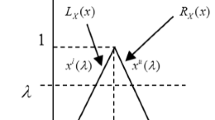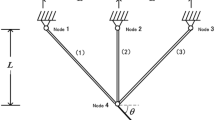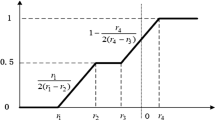Abstract
The output of structure under fuzzy uncertainty can be classified into three cases, i.e., safety-failure case corresponding to that failure and safety both can occur in different membership levels, absolute failure case corresponding to that only failure can occur, and absolute safety case corresponding to that only safety can occur in any membership level. The existing fuzzy possibilistic safety degree measure models can only distinguish the structural safety degree in the safety-failure case but play no role in the absolute failure case and absolute safety case. Aiming at addressing this issue, a novel fuzzy possibilistic safety degree measure model is proposed. Before establishing the new fuzzy possibilistic safety degree measure model, a new value-interval ranking technique is first constructed. Then, the new safety possibility and failure possibility are estimated by synthesizing the information in the entire uncertain space based on the proposed value-interval ranking technique. The new fuzzy possibilistic safety degree measure model can distinguish the structural safety degree in all the three cases, and the results coincide with the human’s intuitive cognition. Several examples involving an engineering application with the finite element model are introduced to show the effectiveness of the established fuzzy possibilistic safety degree measure model.















Similar content being viewed by others
References
Aouaouda S, Chadli M, Moukhnifer M, Karimi HR (2015) Robust fault tolerant tracking controller design for vehicle dynamics: a descriptor approach. Mechatronics 30:316–326
Appadoo SS, Bhatt SK, Bector CR (2008) Application of possibility theory to investment decisions. Fuzzy Optim Decis Making 7(1):35–57
Bae HR, Grandhi RV, Canfield RA (2004) Epistemic uncertainty quantification techniques including evidence theory for large-scale structures. Comput Struct 82(13–14):1101–1112
Bai X, Liu Y (2014) Semideviations of reduced fuzzy variables: a possibility approach. Fuzzy Optim Decis Making 13(2):173–196
Beer M, Ferson S, Kreinovich V (2013) Imprecise probabilities in engineering analyses. Mech Syst Signal Process 37:4–29
Calderaro V, Lamberti F, Galdi V et al (2018) Power flow problems with nested information: an approach based on fuzzy numbers and possibility theory. Electr Power Syst Res 158:275–283
Chen M, Wang SG, Wang PP (2016) A new equivalent transformation for interval inequality constraints of interval linear programming. Fuzzy Optim Decis Making 15(2):155–175
Chen F, Huang GH, Fan YR et al (2017) A copula-based fuzzy chance-constrained programming model and its application to electric power generation systems planning. Appl Energy 187:297–309
Cheng CH, Mon DL (1993) Fuzzy system reliability analysis by interval of confidence. Fuzzy Sets Syst 56(1):29–35
Cheng GH, Huang GH, Dong C et al (2017) Distributed mixed-integer fuzzy hierarchical programming for municipal solid waste management. Part I: System identification and methodology development. Environ Sci Pollut Res 24(8):7236–7252
Cremona C, Gao Y (1997) The possibilistic reliability theory: theoretical aspects and applications. Struct Saf 19(2):173–201
Dempster AP (1967) Upper and lower probabilities induced by a multivalued mapping. Ann Math Stat 38(2):325–339
Dubois D, Prade H (1988) Possibility theory: an approach to computerized processing of uncertainty. Plenum Press, New York
Echard B, Gayton N, Lemaire M (2011) AK-MCS: an active learning reliability method combining Kriging and Monte Carlo simulation. Struct Saf 33:145–154
Fan CQ, Lu ZZ, Shi Y (2018) Safety life analysis under the required failure possibility constraint for structure involving fuzzy uncertainty. Struct Multidiscip Optim 58(1):287–303
Feng KX, Lu ZZ, Pang C, Yun WY (2019) Time-dependent failure credibility analysis and its optimization based computational methods. Eng Struct 181:605–616
Guo SX, Lu ZZ (2002) Hybrid probabilistic and non-probabilistic model of structural reliability. J Mech Strength 24(4):524–526
Guo SX, Lu ZZ, Feng YS (2001) A non-probabilistic model of structural reliability based on interval analysis. Chin J Comput Mech 18:56–60
Guo SX, Zhang L, Li Y (2002) Procedures for computing the non-probabilistic reliability index of uncertain in structures. Chin J Comput Mech 22:227–231
Huang ZL, Jiang C, Zhang Z, Fang T, Han X (2017a) A decoupling approach for evidence-theory-based reliability design optimization. Struct Multidiscip Optim 56:647–661
Huang CZ, Nie S, Guo L et al (2017b) Inexact fuzzy stochastic chance constraint programming for emergency evacuation in Qinshan nuclear power plant under uncertainty. J Environ Inf 30:1): 1–1): 7
Hurtudo J, Alvarez D (2012) Fuzzy structural analysis based of fundamental reliability concepts. Comput Struct 112–113:183–192
Ishihuchi H, Tanaka M (1990) Multiobtective programming in optimization of the interval objective function. Eur J Oper Res 48:219–225
Jia BX, Lu ZZ (2018) Root finding method of failure credibility for fuzzy safety analysis. Struct Multidiscip Optim 58(5):1917–1934
Jiang C, Zheng J, Han X (2018) Probability-interval hybrid uncertainty analysis for structures with both aleatory and epistemic uncertainties: a review. Struct Multidiscip Optim 57(6):2485–2502
JQ Wang ZZL, Shi Y (2018) Aircraft icing safety analysis method in presence of fuzzy inputs and fuzzy state. Aerosp Sci Technol 82–83:172–184
Kabir S, Walker M, Papadopoulos Y (2016) Fuzzy temporal fault tree analysis of dynamic systems. Int J Approx Reason 77:20–37
Khan UT, Valeo C (2017) Comparing a Bayesian and fuzzy number approach to uncertainty quantification in short-term dissolved oxygen prediction. J Environ Inf 30:1):1–1)16
Lee I, Choi KK, Noh YJ, Lamb D (2013) Comparison study between probabilistic and possibilistic methods for problems under a lack of correlated input statistical information. Struct Multidiscip Optim 47(2):175–189
Li DQ, Gu YD (2008) Method for ranking interval numbers based on possibility degree. J Syst Eng 23(2):243–246
Li B, Zhu M, K X (2000) A practical engineering method for fuzzy reliability analysis of mechanical structures. Reliab Eng Syst Saf 67(3):311–315
Liu BD (2002) Uncertainty theory, 2th edn. Springer, New York
Liu X, Da Q (1999) A satisfactory solution for interval number linear programming. J Syst Eng 14(2):123–128
Liu X, Wang XY, Sun L, Zhou ZH (2019) An efficient multi-objective optimization method for uncertain structures based on ellipsoidal convex model. Struct Multidiscip Optim 59(6):2189–2203
Makrehchi M, Basir OA, Kamel M (2003) Generation of fuzzy membership function using information theory measures and genetic algorithm. Fuzzy Sets and Systems-IFSA 2003, 10th International Fuzzy Systems Association World Congress, Istanbul, Turkey, June 30–July 2, 2003, Proceedings DBLP
Melchers RE (2003) Probabilistic model for marine corrosion of steel for structural reliability assessment. J Struct Eng 129(11):1484–1493
Moore R, Lodwick W (2003) Interval analysis and fuzzy set theory. Fuzzy Sets Syst 135(1):5–9
Nakahara Y, Sasaki M, Gen M (1992) On the linear programming problems with interval coefficients. Int J Comput Ind Eng 23:301–304
Onisawa T (1991) Fuzzy reliability assessment considering the influence of many factors on reliability. Int J Approx Reason 5(3):265–280
RE Moore (1966) Interval analysis. Prentice Hall, Englewood Cliffs
Ruiz JL, Sirvent I (2017) Fuzzy cross-efficiency evaluation: a possibility approach. Fuzzy Optim Decis Making 16(1):1–16
Senguta A, Pal TK (2000) On comparing interval numbers. Eur J Oper Res 127:28–43
Shafer G (1976) A mathematical theory of evidence. Princeton University press, Princeton
Shi Y, Lu ZZ, Cheng K (2017) Temporal and spatial multi-parameter dynamic reliability analysis and global reliability sensitivity analysis based on the extreme value moments. Struct Multidiscip Optim 56(1):117–129
Shi Y, Lu ZZ, Zhou YC (2018a) Global sensitivity analysis for fuzzy inputs based on the decomposition of fuzzy output entropy. Eng Optim 50(6):1078–1096
Shi Y, Lu ZZ, Chen SY, Xu LY (2018b) A reliability analysis method based on analytical expressions of the first four moments of the surrogate model of the performance function. Mech Syst Signal Process 111:47–67
Shi Y, Lu ZZ, Xu LY, Chen SY (2019) An adaptive multiple-Kriging-surrogate method for time-dependent reliability analysis. Appl Math Model 70:545–571
Sui S, Tong SC (2016) Fuzzy adaptive quantized output feedback tracking control for switched nonlinear systems with input quantization. Fuzzy Sets Syst 290:56–78
Sui S, Tong SC, Chen CLP (2018) Finite-time filter decentralized control for nonstrict-feedback nonlinear large-scale systems. IEEE Trans Fuzzy Syst 26(6):3289–3300
Wang C, Li J, Guo PJ (2015a) The normalized interval regression model with outlier detection and its real-world application to house pricing problems. Fuzzy Sets Syst 274(1):109–123
Wang S, Huang G, Baetz BW (2015b) An inexact probabilistic-possibilistic optimization framework for flood management in a hybrid uncertain environment. IEEE Trans Fuzzy Syst 23(4):897–908
Wang C, Qiu ZP, Xu MH, Li YL (2017a) Novel numerical methods for reliability analysis and optimization in engineering fuzzy heat conduction problem. Struct Multidiscip Optim 56(6):1247–1257
Wang C, Qiu ZP, Xu MH (2017b) Novel fuzzy reliability analysis for heat transfer system based on interval ranking method. Int J Therm Sci 116:234–241
Wang C, Martthies HG, Qiu ZP (2017c) Optimization-based inverse analysis for membership function identification in fuzzy steady-state heat transfer problem. Struct Multidiscip Optim 57(4):1495–1505
Xu ZS, Da QL (2003) Possibility degree method for ranking interval numbers and its application. J Syst Eng 18(1):67–70
Xu Z, Du Q (2003) An approach to improving consistency of fuzzy preference matrix. Fuzzy Optim Decis Making 2(1):3–12
Yan Shi ZZL, Zhou YC (2018) Time-dependent safety and sensitivity analysis for structure involving both random and fuzzy inputs. Struct Multidiscip Optim 58(6):2655–2675
Zadeh LA (1978) Fuzzy sets as a basis for a theory of possibility. Fuzzy Sets Syst 1(1):3–28
Zadeh KL (2000) Fuzzy sets and fuzzy information granulation theory. Beijing Normal University press, Beijing
Zhang LG, Lu ZZ, Chen J (2014) An efficient method for failure probability-based moment-independent importance measure. Acta Aeron Astronaut Sin 35(8):2199–2206
Zhang F, Huang Z, Yao HJ, Gao TF (2016) Icing severity forest algorithm under both subjective and objective parameters uncertainties. Atmos Environ 128:263–267
Zhou PZ, Du JB, Lu ZH (2017) Interval analysis based robust optimization with continuous and discrete variables using mix-coded genetic algorithm. Struct Multidiscip Optim 56(2):353–370
Acknowledgments
The authors thank the reviewers’ constructive and helpful suggestions and comments on the paper.
Funding
This work was supported by the National Natural Science Foundation of China (Grant 51475370), the National Science and Technology Major Project (2017-IV-0009-0046) and the Innovation Foundation for Doctor Dissertation of Northwestern Polytechnical University (Grant CX201931).
Author information
Authors and Affiliations
Corresponding author
Ethics declarations
Conflict of interest
The authors declare that they have no conflict of interest.
Additional information
Responsible Editor: Somanath Nagendra
Publisher’s note
Springer Nature remains neutral withregard to jurisdictional claims in published mapsand institutional affiliations.
Highlights
• Novel fuzzy safety possibility and failure possibility are proposed.
• A new value-interval ranking technique is established.
• The interval safety possibility and failure possibility are estimated by the new value-interval ranking technique.
• The novel fuzzy safety degree model can distinguish the structural safety degree for different cases.
The demonstration for the equivalency of \( {\pi}_f^{\mathrm{orig}} \) and πf
The demonstration for the equivalency of \( {\pi}_f^{\mathrm{orig}} \) and πf
Based on the definition of the failure possibility πf in (1), it can be written as follows:
For demonstrating the equivalency of \( {\pi}_f^{\mathrm{orig}} \) and πf, three cases are considered, i.e., case 1 for 0 < πf < 1, case two for πf = 0, and case 3 for πf = 1. For case 1 where 0 < πf < 1, it is supposed that the failure possibility equals to λ∗(0 < λ∗ < 1), i.e., πf = λ∗, and it is shown in Fig. 16.
From Fig. 16, one can see that the failure possibility πf equals to the membership level λ∗ which satisfies \( {\underset{\_}{G}}_{F{\lambda}^{\ast }}=0 \). Therefore, (3) can be further written as follows:
Thus, the original-fuzzy failure possibility \( {\pi}_f^{\mathrm{orig}} \) shown in (5) can be estimated by:
For case 2 where πf = 0, the failure possibility πf is shown in Fig. 17.
In this case, (3) can be further written as follows:
The original-fuzzy failure possibility \( {\pi}_f^{\mathrm{orig}} \) shown in (5) can be estimated by:
For case 3 where πf = 1, the failure possibility πf is shown in Fig. 18.
In this case, (3) is further expressed as follows:
Thus, the original-fuzzy failure possibility \( {\pi}_f^{\mathrm{orig}} \) shown in (5) is estimated by:
Therefore, the failure possibility πf defined in (Cremona and Gao 1997) is equivalent to the original-fuzzy failure possibility \( {\pi}_f^{\mathrm{orig}} \) defined in (5).
Rights and permissions
About this article
Cite this article
Shi, Y., Lu, Z. Novel fuzzy possibilistic safety degree measure model. Struct Multidisc Optim 61, 437–456 (2020). https://doi.org/10.1007/s00158-019-02365-w
Received:
Revised:
Accepted:
Published:
Issue Date:
DOI: https://doi.org/10.1007/s00158-019-02365-w







